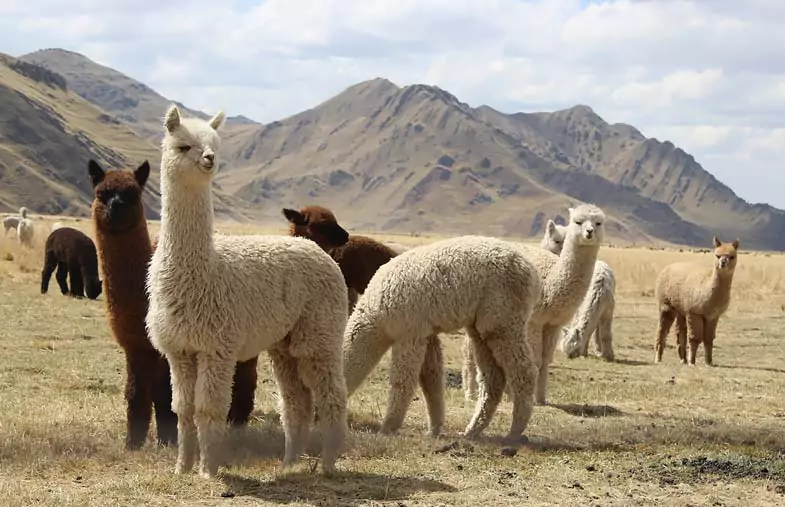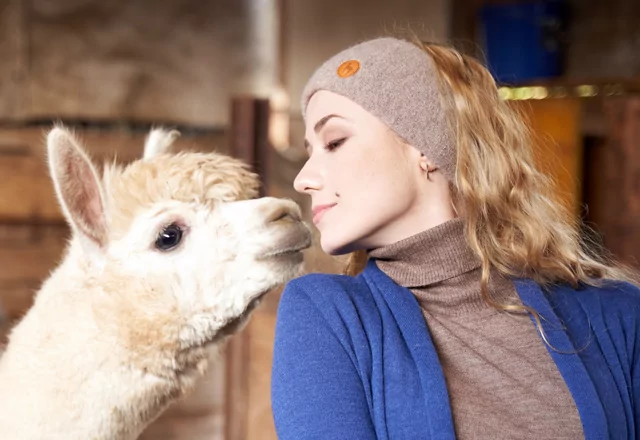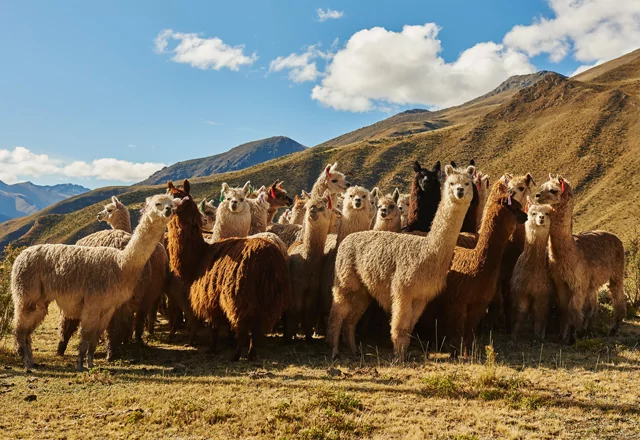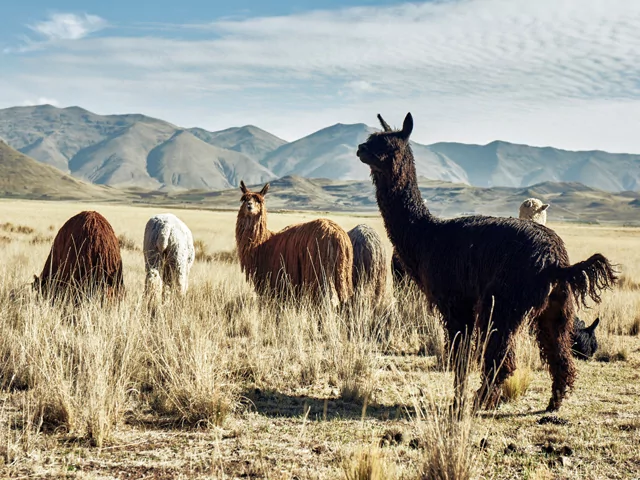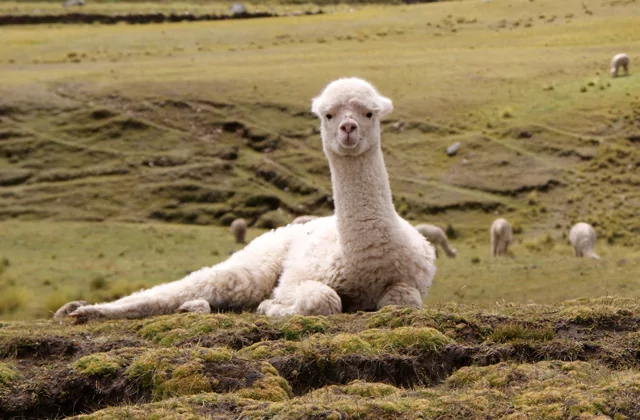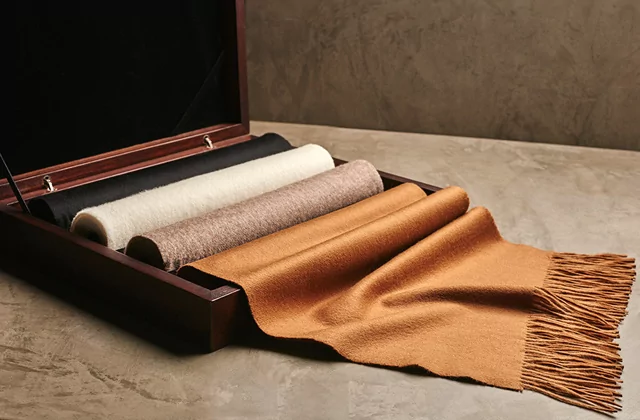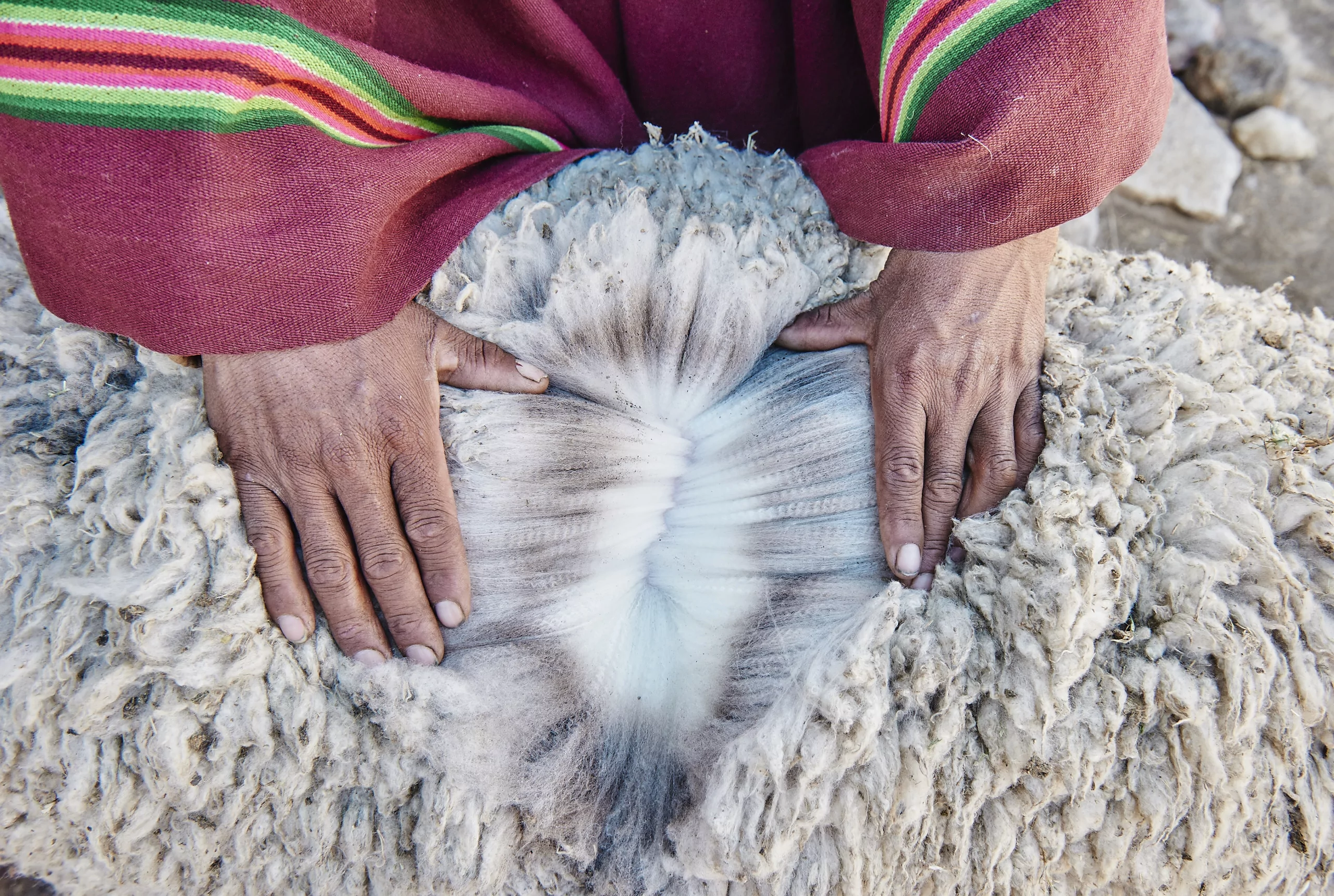Cellular structure
Alpaca has a special cell structure of fibers. This consists of different scales that interlock. The step of the individual scales is called "scale height". This scale height is about 0.4 microns for alpaca fiber; about 0.8 microns for sheep's wool. The greater the scale height, the more uncomfortable and scratchy a fiber feels against the skin and the more likely it is to mat. In addition, alpaca contains almost no lanolin (wool grease), which is why it feels so fluffy. Another advantage is that time-consuming dry cleaning, as required for sheep's wool, is not necessary and the processing of the fiber is enormously facilitated. Even freshly sheared alpaca wool feels completely dry and fluffy and, depending on how dirty it is, does not need to be cleaned at all. Another reason is the fineness of the fiber. Alpacas are among the finest fiber animals in the world. The fineness of the alpaca fiber or wool is measured in "microns". This is a measurement of the diameter of the animal's hair.
The lower the micron value of a fiber, the softer the fiber feels and the finer and higher quality the garment will later be. There are different fineness classes, but we always use only the three finest alpaca hairs - royal, baby, and superfine alpaca. The alpaca fibers we process have a fineness of 19 - 27 microns (i.e. micrometers), which corresponds on average to between 0.019 - 0.027 millimeters. This wonderful fineness is one reason for the many advantages of alpaca fiber.
For comparison, human hair has a thickness of 70 microns (0.07 millimeters).
Baby Alpaca
At a glance:
- - Today, this exceptional fiber plays a fundamental role in the world of textiles
- - High performance in extreme weather conditions
- - Incredibly soft to the touch
- - Wide range of products
It is a fiber known worldwide for its softness and subtle luster. Baby alpaca has the greatest chromatic diversity that exists in the world of weaving - 22 natural shades that go from white, brown, and gray to black.
Through the experienced hands of artisans who still know the ancient secrets and which fibers to choose by hand, baby alpaca gets its exquisite quality and an average fineness between 20 and 22.5 microns. Besides its warmth and softness, the inspiration and basis for the development of Andean textiles were mainly the Incas.
Alpaca 16
At a glance:
- - Delicate sheen
- - Exclusive selection
- - Unsurpassed softness
- - Limited and numbered products
The finest alpaca garments in the world.
The finest selection of alpaca fiber ever won is called Alpaca 16, which is unbeatably soft to the touch and has a subtle sheen. The fiber comes from the National Alpaca Fiber Competition held annually at KUNA's Experimental Station for Scientific Research and Genetic Development: Pacomarca. It has a fineness of 16.7 microns, a world record for alpaca fiber that has never been achieved before and that only KUNA possesses.
The production of Alpaca 16 belongs to a small batch made up of fibers from the best alpaca breeders in Peru, finalists in the competition "El Quintal del Inca", which allows 100% traceability. Therefore, each item is numbered.
Royal Alpaca
At a glance:
- - Subtle sheen
- - Silky in appearance
- - Beautiful uniqueness
- - Incredibly soft to the touch
Royal Alpaca is the most sophisticated selection of the best alpaca fibers from both breeds (Suri and Huacaya). Performed by expert hands of artisans who have mastered ancient secrets and later by a mechanized process that allows them to choose the finest fiber. Soft and warm, with that elegant and subtle luster that also includes the magnificent range of tones that this wonderful fiber can offer. All this makes it possible that the garments made with this material have an unmistakable elegance and personality.
KUNA guarantees that ROYAL ALPACA yarns come from fleeces of maximum fineness (up to 18 microns) and offer a feeling of comfort comparable to that of other very fine hair such as cashmere, camel, extra fine wool, etc.
Black Alpaca
At a glance:
- - Exclusive and very limited selection
- - Numbered pieces
- - 100% natural black fiber
- - Of high fineness and uniformity
- - It symbolizes KUNA's efforts to preserve the black alpacas
The rarest natural fiber color in the world is black, and Peru is the country with the highest number of black alpacas. However, the number of pure black alpacas in Peru has dropped to about 5,000 animals in recent years.
BLACK ALPAKA is a fascinating and exclusive collection that symbolizes KUNA's effort to preserve pure black alpacas, which are currently threatened with extinction. Thanks to Pacomarca we can say that KUNA has the largest existing group of these animals, which they study, care for, and propagate to promote their breeding in the rest of the country.
Baby Alpaca Suri
At a glance:
- - Beautiful uniqueness
- - Silky in appearance
- - Incredibly soft to the touch
- - Exclusive and of countless qualities
The Suri breed represents only 6% of the total population of alpacas. It produces a very fine fleece that covers it like a coat, made up of long wicks up to 16 cm long; this fall vertically on the neck and around the entire body, giving it a unique beauty.
It is the crowning glory of the selection of alpaca fibers since only 0.5% of the total alpaca fiber processed corresponds to this noble input. BABY ALPACA SURI is one of the most precious fibers of the South American camelids, thanks to its beautiful variety of colors, its fineness, its softness, and its natural shine, which gives a visible and very special elegance to the garments.
Guanaco
At a glance:
- - Hypoallergenic
- - Silky in appearance
- - Incredibly soft to the touch
- - Thermoregulating properties
The guanaco produces a very fine fiber of a delicate cinnamon color. A warm and silky raw material, it is used by KUNA to make garments that, in addition to their excellent quality, have an unusual charm related to the evolution of Andean man, who, like the vicuña, uses the chaccu as a shearing method for this animal.
Today, KUNA painstakingly collects guanaco fibers certified by CITES in a wide area of the Andes. These fibers are hand-selected to ensure that their luster and special softness are of the highest quality. This makes it possible to produce garments of refined beauty that preserve the unique charm of nature.
Marketing of fibers certified by the Peruvian Ministry of Agriculture and Irrigation and CITES (Convención sobre el Comercio Internacional de Especies Amenazadas de Fauna y Flora Silvestre).
Vicuna
At a glance:
- - Hypoallergenic
- - The Peruvian national symbol
- - Considered "the gold of the Andes"
- - Its fiber varies between 11 and 13.5 microns
- - Lightweight and with thermoregulatory properties
- - The marketing of its fibers is certified by the Peruvian Ministry of Agriculture and Irrigation and by CITES (Convención sobre el Comercio Internacional de Especies Amenazadas de Fauna y Flora Silvestre)
The most beautiful of the South American camels, this wonderful animal with the finest animal fiber in the world, served the ancient Andean weavers as the most valuable raw material from which they made wonderful clothes for the Inca kings.
Vicuñas are shorn only every 2 years on the back and sometimes on the neck. The ancestral knowledge of the Andean communities is used to obtain the fibers, through the shearing method called Chaccu, which makes it possible to obtain this valuable fiber while preserving the integrity and freedom of this wonderful animal. The yield per shearing and animal is only 125 to 150g. Of this, 43-47% of the best fibers are sorted out by hand. Likewise, it is the heritage of these communities that manage to keep intact the qualities of this fiber, as they perform a delicate descerdado by hand. An infinite effort that pays off for this incomparable quality.
Vicuna is so rare, yet so fine and soft, that even the world's greatest couturiers go into raptures over this fiber. No wonder, because this fiber may only be processed by three manufacturers worldwide. And only a few of them have the chance to use yarns and fabrics made of vicuna for their exquisite collections.
KUNA has taken on the fascinating challenge of ensuring the survival of vicuña and its rich heritage by employing thousands of Peruvians from KUNA and being the only brand in the world that follows the production process from start to finish. They transform the extremely fine vicuna fiber into garments of delicate beauty, whose softness to the touch is a privilege that fills with pride.

 English
English  Deutsch
Deutsch Français
Français






